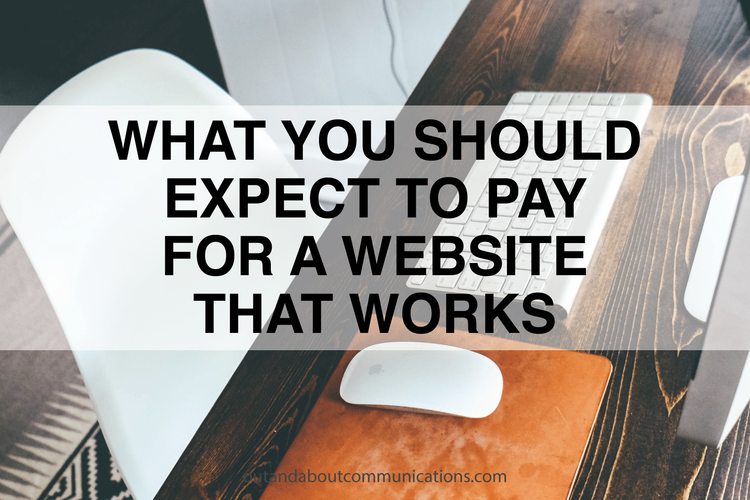
By Lauren Hong
When it comes to running a business, it’s no secret that your expense docket is likely a mile long. There are a lot of things to consider when it comes to keeping the doors open and the lights on. There are also a lot of places where you can follow lean principles to do more with less. But let us get one thing straight: your website isn’t always one of those places.
Your website is your online home; your 24/7 salesperson who’s welcoming people in the front door when the rest of the crew has long been fast asleep. It’s the lead-generating, customer-satisfying, information-offering machine that, when well-oiled, is going to differentiate your business from the rest before your potential customers even get a chance to meet your (stellar) team.
But when it comes down to it, a great website -- one that does all of the above -- can end up with a bill of anywhere from $5,000 to $30,000 -- and sometimes, even more.
Before your jaw drops fully to the ground, let’s be clear: most web designers and developers aren’t trying to give you the runaround. It’s simply that most people just don’t understand the true cost of what goes into building a website -- and why and how a project can jump from $5k to $30k in no time.
You want to be the educated customer going into a web development deal with understanding. We want to help you get there so that you’re not catching flies when they hit you with the price.
When you’re buying art…
Let’s talk about that wide gap in price estimates, first. Why the discrepancy? Consider this scenario: you’re walking down an alley in a big city when you stumble upon a small studio. Inside is an artist toiling away at paintings that you just happen to fall in love with at first sight.
After browsing, you find that you can pick up this artist’s work in a few different forms: the original piece, which is going to run you a cool $30k, a limited-edition canvas giclée for $8,000, or a run-of-the-mill print for $200.
Here, the discrepancy seems obvious. When you buy the original, you’re paying for something one-of-a-kind; something that took the artist hours on end to complete; something uniquely made only for the person who ends up buying it.
The scale of website costs will vary in the same way, with major variants largely based on three elements: customization, talent, and experience. Customization will dictate the amount of time and energy put into designing it and developing it, and talent will dictate that level of customization. Finally, as with most things, you often pay for the experience you want. Your designer/developer is the artist, and you’re the customer that decides exactly how unique you want your site to be, and what bells and whistles are going to set you apart.
With that established, let’s take a look at what average price breaks might look like.
1. The DIY and/or cookie-cutter template
We like to think of this as the starter home for your online presence. Basic websites -- especially those that are DIY -- can be created for anywhere from $50/month to $2k+ at once.
When it comes to DIY, there’s no scarcity of resources to help you get it done, or platforms to enable you to do so. You can get your business started with a clean-cut site on platforms like Squarespace or Wix for anywhere from $5 - $36/month and not have to worry about hosting or domain (for the first year). The benefit? They make DIY-ing decently straightforward. The bad news? The potential is limited.
For a simple splash page, a standard blog, or even a multi-page site that’s purely informational, these are fantastic options for a business or individual that doesn’t need a strong web presence. And if you’re not completely comfortable using them yourself, a developer will have minimal costs for setting you up on these platforms.
But if you’re looking for anything more -- from a custom template to a bonafide e-commerce store -- you’re either going to spend a lot of time attempting to figure things out that you don’t know much about, or you’re going to end up paying a developer a handsome fee to give a cookie cutter template that personal touch.
This is the print when it comes to that painting you really liked before. Let’s take a look at what that giclée will get you.
2. The tailored-to-you site
So, you know you don’t want cookie cutter -- and you certainly don’t want to go to a developer each time you want to publish a blog post. Let’s take a look at what spending a little more -- we’re talking anywhere from $5,000-$15,000 -- will get you.
Content management system: What makes platforms like WordPress and Shopify so popular is that they have built-in content management systems (CMS). This lets you update your website easily.
Customized aesthetics: With the help of a graphic and/or user experience designer, you lay out a site that is uniquely you -- your brand, your tone, your navigation.
Specialized coding: At this level, you’re likely engaging an experienced developer that can take a pre-made template or a theme and overlay custom code, including custom storefronts or optimized lead generation funnels. Responsive design, which easily adjusts your website depending on the device it’s viewed on, shouldn’t even be a question here.
Extra bells + whistles: Depending on where you fall in the price range here, your development team may also include copywriters, SEO specialists and data analysts that can help develop content, optimize your site for search engines, and set up goal tracking for analytics.
When you go this route, you’re not looking at a start-from-scratch, completely custom website, but you are looking at spending a little more to work with designers and developers that can take a standard site and tailor it to your brand and your business. Best of all? You’re not required to crack open HTML for Dummies, saving time upfront, but you are able to make your own updates later, saving money down the line.
3. The completely custom, uniquely you site
We’ve finally arrived at that original painting you’ve been eyeing for that cool $30k. Only, when it comes to a website, a completely custom site built just for your business can run you anywhere from $15,000-$100,000 and beyond.
What does it mean for you? A fully custom, easy-to-update, SEO-optimized site that includes more pages, databases, and unique functionality than you could receive at any other level. This option is made for two types of businesses: big businesses with complex business models, divisions, or offerings; and businesses that, no matter their size, hold a heavy web presence and do most of their business online.
This requires developers who are incredible problem solvers; who know several coding languages and can intertwine them; who understand your business’ goals and can build a site that enables you to reach them.
4. Custom apps
This one’s in a league of its own: custom applications (think: web apps that function separately from a website like what you find in the Chrome app store, or stand alone apps on your mobile devices).
If you’re enlisting the help of a developer to build a custom application, you’re likely out to solve a very specific problem. Despite that, building custom apps that can function on several platforms is hardly simple, so you can expect yours to cost anywhere from $2,500-$10,000+ as a rough ballpark.
After all… Instagram wasn’t built in a day.
What does your business need?
To help you make the decision, here are a few questions to guide your thought process:
What’s the opportunity cost? We’re willing to bet that when it comes to web design and development, your time is better spent doing what you
do best than peeling through CSS and PHP forums trying to figure out where you went wrong in the code. Time is money.
What’s going to set me apart? Depending on your industry, it might be enough to have a clean website that presents accurate information. If competition runs a little stiffer than that, you’re likely going to want to up the functionality and customization to set your business apart. Consider the top 3-5 things that would do so (things like built-in scheduling software, a searchable directory, or sharing capabilities, for example) and focus your efforts there.
What do I need my website to accomplish? Like most things in business, bring it back to your overall goals. Where does your website fit in? Is it a lead generation machine that’s crucial to cultivating relationships and sales? Is it a self-functioning store? Or a simple digital brochure for your business?
You get what you pay for
We can sum it up as simple as this: you get what you pay for. Can you get a beautiful, functional website on the cheap? Sure. But in most instances where you want your website to work for you, it’s best to value custom over cookie cutter and talent over a tight wallet. Be the customer who appreciates the original painting, and you’ll have something to show for it. Growing businesses can’t afford to have a web presence that isn’t modernized, responsive (works on phones, tablets etc.), and aligned with your brand. You’re losing dollars by not letting your website be the sales and marketing introduction to your business.






